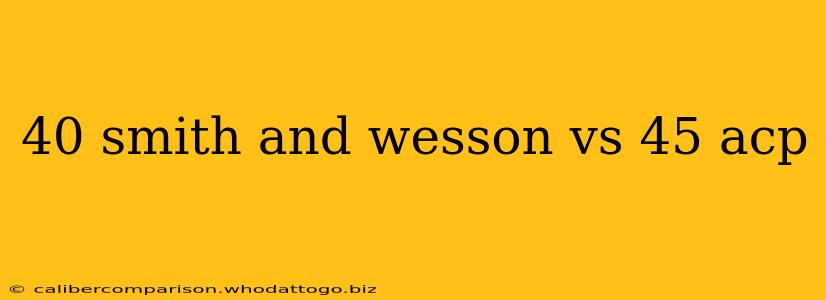Choosing the right caliber for self-defense or personal protection is a crucial decision, and the debate between the .40 Smith & Wesson (often shortened to .40 S&W) and the venerable .45 ACP continues to spark passionate discussion among firearm enthusiasts and professionals alike. This in-depth comparison will analyze both calibers, considering ballistics, stopping power, recoil, capacity, and other factors to help you make an informed choice.
Ballistics: A Closer Look at the Numbers
Understanding the ballistics of each cartridge is fundamental to comparing their effectiveness. We'll look at common bullet weights and velocities:
.40 Smith & Wesson
- Typical Bullet Weight: 165-180 grains
- Typical Muzzle Velocity: 1000-1200 feet per second (fps)
- Energy: Generally ranges from 400 to 600 ft-lbs
The .40 S&W offers a balance between velocity and weight, resulting in a respectable amount of energy upon impact. This translates to good penetration and expansion capabilities with appropriately designed ammunition.
.45 ACP
- Typical Bullet Weight: 230 grains
- Typical Muzzle Velocity: 850-1000 fps
- Energy: Typically ranges from 350 to 500 ft-lbs
The .45 ACP boasts a significantly heavier bullet, leading to substantial stopping power, often attributed to its large diameter and forceful impact. However, it generally possesses a lower muzzle velocity compared to the .40 S&W.
Stopping Power: The Crucial Factor
Stopping power, the ability of a cartridge to incapacitate an attacker quickly, is a complex topic heavily debated. While the .45 ACP is often lauded for its "knock-down" power due to its large diameter and mass, the effectiveness of any round depends on shot placement. A well-placed shot from a .40 S&W can be equally effective.
Both calibers are capable of stopping threats, but the significance of shot placement cannot be overstated. Training and accuracy are far more critical than the caliber choice itself.
Recoil: Managing the Force
Recoil is a crucial consideration, especially for new shooters or those with less upper body strength.
- .40 S&W: The .40 S&W exhibits noticeable recoil, manageable for most, but still substantial enough to impact follow-up shots.
- .45 ACP: The .45 ACP typically generates heavier recoil than the .40 S&W. This can make rapid follow-up shots more challenging.
Magazine Capacity: Rounds on Tap
Magazine capacity varies greatly depending on the firearm model, but generally:
- .40 S&W: Often offers higher magazine capacity than .45 ACP handguns.
- .45 ACP: Usually has lower magazine capacity due to the larger cartridge size.
Ammunition Availability and Cost: Practical Considerations
Both .40 S&W and .45 ACP ammunition are readily available, although prices fluctuate based on market demand and manufacturer.
Conclusion: Choosing the Right Caliber
The "better" caliber, .40 S&W or .45 ACP, ultimately depends on individual needs and preferences. There's no universally superior choice.
-
Choose .40 S&W if: You prioritize higher magazine capacity, slightly less recoil, and potentially faster follow-up shots.
-
Choose .45 ACP if: You value perceived stopping power, despite heavier recoil and potentially lower capacity.
Regardless of your caliber choice, rigorous training, proper firearm handling techniques, and accurate shot placement are paramount to effective self-defense. Consult with experienced firearm instructors and range professionals before making your decision. This comparison provides a foundation for informed decision-making, but personal experience and professional guidance are invaluable.

